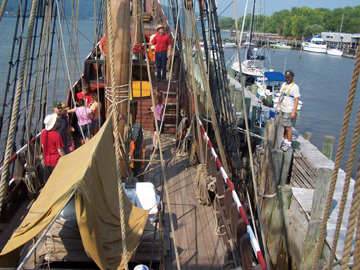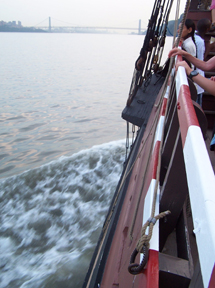 |
|
|
 |
Photo montage of the Half Moon docked at King Marine. |
1200 hours
Current Position: Docked at King Marine, Verplanck, NY
Day One of the first leg of our Voyage of Discovery.
As the Fall 2007 Voyage of Discovery begins, the Half Moon has been moored here in Verplanck for several days while our senior crew saw to the final preparations and eagerly anticipated the arrival of our student crew.
|

1230 hours
And here they are! The student crew for the first leg of our voyage arrives right on schedule.
|

The students quickly transfer their gear off the bus and takes in their surroundings.
|

Captain Reynolds comes out to welcome the students and offer a few introductory words on what they can expect.
|

With no further delay, the students march their gear down to the end of the dock, where the Half Moon awaits.
|
 
After we relay our new arrivals' equipment on board, the students themselves carefully cross over onto the ship.
|

1300 hours
Once our entire crew is on deck, Captain Reynolds briefs everyone on our safety procedures. The students won't start working on their academic projects until tomorrow, but the Half Moon is a learning experience from the moment they step on board. Before they can progress to anything else, the students must learn how to keep themselves and their crewmates safe.
Dr. Ray Phillips, a friend of the ship, is also on hand to examine the crew's medical forms, ensuring that we know about our crew members' allergies, dietary requirements, and the like.
|

1315 hours
One of our floating neighbors here at King Marine comes over for a quick visit. Yes, it's Biminy the parrot, and he's even brought his owner. (Or is it she? Biminy is a young parrot, so it's hard to tell.) Either way, Biminy proves a popular guest.
|

Once our new crew members have their gear stowed below and are feeling comfortable, we serve their first meal on board.
Today's lunch consists of chicken wraps, rice, and salad.
|

1430 hours
The time has come for the Half Moon to depart. The Colleys rig a springline in Dock Line Three. With this in place, we'll be able to free the final mooring line from on board the ship. This allows us to leave port without outside assistance.
|
 |
Mouse over to see us underway. |
1445 hours
Once the dock line is rigged, our new crew are assigned to dock lines. This is the students' first opportunity to work together as a single crew: As Mr. Colley frees our mooring lines on the dock, the students on board haul them into the ship.
Once Mr. Colley steps back onto the ship, we pull Line Three and are on our way.
|

Our new crew members are divided into two alternating duty watches: Port Watch and Starboard Watch, as they are traditionally known.
Since they're on duty from 12 to 6 o'clock (both PM and, when needed, AM), the students of Starboard Watch assume their posts as we set out. On the fore deck, Aaron takes position as our first lookout.
|

Meanwhile, at the helm, Mr. Prime shows Abbegail how to use the whipstaff -- a simple lever that predates the invention of the ship's wheel -- to steer the Half Moon.
By the conclusion of this Voyage of Discovery, every student will have learned how to perform the duties of every post on the ship.
|

1500 hours
Below decks, other students learn how to use the head. They also learn how to perform fire & bilge duty, carefully monitoring the ship for potential dangers. With the crew member rotating through the task of seeking out rising bilge water, signs of smoke or fire, and odd smells throughout every hour of day, we can protect the Half Moon from hazards before they even happen.
|

1530 hours
Throughout the afternoon, Mr. and Mrs. Colley introduce groups of students to their first lessons in shipcraft. First and foremost, the students learn how to properly belay and coil a line. In coming days, they'll build on this basic skill until, ultimately, they can man the sails.
|

While Mrs. Colley leads students through their coiling lessons on deck, Mr. Colley continues to lead other groups of students on tours below deck, introducing them to fire & bilge duty and the galley.
|

Dr. Phillips usually just examines our crew's medical forms at the dock before seeing us off, but today he's decided to join us for the first day of our voyage. While on board, he spends much of his time helping to stand lookout on the fore deck, enjoying the scenery and getting to know our student crew.
|

1645 hours
The crew continues to give groups of students their first lessons in shipcraft. Here, Mrs. Colley has Fatima and Aaron demonstrate how to coil their lines.
|

Meanwhile, w e pass under the Tappan Zee Bridge. Karyn isn't quite sure that our main mast will clear the bridge until she sees it with her own eyes.
|
 
1745 hours
The Colleys and Mr. Dawson introduce their first group of students to knot-tying. The students enjoy learning a bowline, but this is just a start -- by the time they complete their voyage, they'll have the opportunity to learn much more.
|

Meanwhile, Ms. Wegman is putting her assistants to work thoroughly cleaning the galley from top to bottom. Our student galley assistants won't just help prepare meals and clean dishes; they'll gain valuable lessons in nutrition and public health.
(But yes, parents -- our students will know how to wash dishes by the time they return home, even if they deny it.)
|

1800 hours
We are now motoring past Yonkers, which is Dr. Phillips' destination. As the crew sees him off, he descends into the Zodiac...
|

...where Mr. Colley and Mr. Dawson quickly zip him to shore. Once they return and we hoist the inflatable boat back out of the water, we continue on our way.
|

1830 hours
Dinner is served on the weather deck. Tonight we're enjoying a veritable feast: salad, applesauce, two different kinds of pasta, and homemade gingerbread for dessert.
While we eat, the Half Moon continues south, motoring along the Pallisades.
|

1900 hours
As dinner winds down, some of our young crew members have already started to ponder which scientific phenomena to study for their presentations. Mr. Prime discusses a range of possible topics with his entourage of interested students.
|
 |
Mouse over to watch our wake. |
As the George Washington Bridge looms from the afternoon haze, we approach our destination for the day and slow our engines.
Meanwhile, the students begin to settle into a relaxing evening.
|

And here we are: the Pallisades. We'll set anchor and remain here overnight before continuing south tomorrow morning.
|

1915 hours
As the abovedecks anchor team frees the anchor, letting it plunge into the depths below, our belowdecks team uses markings like this one to measure how much of the anchor rode (heavy line) to let out. Each band equals fifty feet.
|

Once we make off the anchor rode, we raise our anchor light, notifying any vessels that pass us in the night of our position.
|

Mr. Dawson remains on the fore channel, indicating which way the anchor rode is trending, while Captain Reynolds makes a few final adjustments from the Quarter deck.
|

1945 hours
Once everything is secure, Captain Reynolds calls all hands on deck for our first anchor watch briefing. The students will monitor the anchor light all night, making sure it doesn't go out, while also watching landmarks on shore for signs that our anchor may be dragging (an uncommon possibility, but one that must be taken seriously).
|

21oo hours
Lights out doesn't officially come for another hour, but once the anchor watch briefing is over most of the students are more than happy to set up their bedrolls on the weather deck and call it a day. As the Half Moon rests at anchor by the glow of the George Washington Bridge, the anchor watch quietly monitors our position through the night.
|
|
On this date in 1609:
The eight, was very faire weather, wee rode still very quietly. The people came aboord us, and brought Tobacco and Indian Wheat, to exchange for Knives and Beades, and offered us no violence. So we sitting up our Boate did marke them, to see if they would make any shew of the Death of our man; which they did not.
-- Robert Juet's Journal.
[As we join the voyage, the Half Moon has entered Raritan Bay, nearing what is now New York Harbor. Just two days earlier, on September 6, 1609, the crew suffered their only casualty during this voyage: an English sailor named John Colman, killed in a hostile encounter. Yesterday, the crew buried him at a locale they named Colmans Point (known today as Sandy Hook, New Jersey). Juet and the crew are now particularly suspicious of everyone they encounter.]
|
| |
|
|
|

